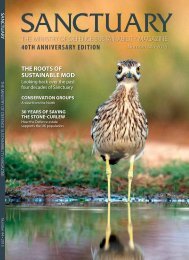SUSTAINABILITY
UBUt5
UBUt5
Create successful ePaper yourself
Turn your PDF publications into a flip-book with our unique Google optimized e-Paper software.
FEATURES<br />
Making a buzz with the<br />
Ministry of Defence<br />
Brown banded male humilis © Bumblebee Conservation Trust<br />
Over the last 60-70 years the UK has<br />
lost over 97% of its ancient wild flower<br />
meadows. During and after the WWII<br />
we had the dig for victory campaign<br />
in which we needed to feed our<br />
population and troops, much of our<br />
common land was put into agriculture<br />
production and the government gave<br />
subsidies to increase the use of<br />
fertilisers and pesticides/insecticides.<br />
This dramatic loss of habitat has had a<br />
significant impact on many of our<br />
farm land species, such as our insect<br />
pollinators. For example, two of our<br />
The first short haired bumblebee seen this year<br />
© Bumblebee Conservation Trust<br />
bumblebee species have become<br />
extinct and a further seven are classed<br />
as rare and threatened. However,<br />
much of the remaining ancient wild<br />
flower meadows remain on MOD<br />
ranges such as Salisbury Plain. Many of<br />
these sites have never been ploughed<br />
or fertilised so the soil has not become<br />
damaged and retains a high level of<br />
floristic diversity.<br />
Insect surveys on MOD land have<br />
demonstrated that many of these<br />
ranges retain a good diversity of<br />
bumblebees and other rare insects.<br />
The Bumblebee Conservation Trust<br />
(BCT) has been working with different<br />
ranges to survey and give advice on<br />
managing wild flower habitat for our<br />
bumblebees. In the south of Kent in<br />
Dungeness and Romney Marsh an<br />
exciting project is taking place to<br />
reintroduce one of the UK’s extinct<br />
species, the short haired bumblebee.<br />
The short-haired bumblebee project<br />
was formed in 2009 by Natural England,<br />
RSPB, Hymettus and BCT. The aim of<br />
this project is to work with local farmers<br />
Identification training walk on the ranges<br />
© Bumblebee Conservation Trust<br />
and other land owners to restore and<br />
recreate wild flower habitat, to<br />
monitor wild flower areas for<br />
bumblebees and to reintroduce this<br />
extinct species from Sweden (where a<br />
good population still remains).<br />
The Short Haired Bumblebee<br />
Reintroduction Project has been<br />
releasing queen bumblebees at<br />
Dungeness for the last four years. The<br />
aim of this is to encourage the species<br />
(which was declared extinct in the UK<br />
in 2000) to re-establish in the area. The<br />
release site is just a few kilometres<br />
from Lydd Ranges, and the<br />
28<br />
Sanctuary 44 • 2015



